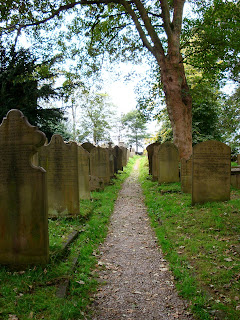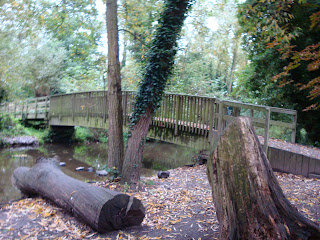Monday, 7 December 2009
Final Article Summary For Shakespeare YAY
Shakespeare Final Paper
Church Interview: Runnette
What Evolution is NOT
My Beatles Paper
Mandi Allen
The Beatles
“Hey Jude”
Sunday, 1 November 2009
Stonehenge, Stourhead and Bath
On October 14th I had the wonderful opportunity to visit Stonehenge, Stourhead and Bath. This day was awesome! We got up around 6:30 AM to pack our lunch and get out the door by 7:30. I slept the entire way to Stonehenge of course so I missed seeing it from a distance but seeing it up close was better anyways. Stonehenge was smaller then I was expecting but I was not disappointed. It was still incredible seeing something that I have heard and learned about my whole life. I feel so incredibly lucky to say I have been to Stonehenge. I think one of the coolest things about Stonehenge is the fact the no one knows why those stones are there, it is mystery and that is what makes it so awesome. Next is Stourhead. I was a little sad when we got to Stourhead because the place where they filmed Pride and Prejudice was closed for Construction. However, even though that place was closed everything else was incredible. It is just crazy to know that someone actually lived there. While being there I realized that no body would ever make such an incredible landscape in today’s world. I think we are so lucky that Stourhead is still there and most of the original landscape is still intact because I feel like you could never find anything as beautiful as the original handcraft landscape they spent the time creating back then. The last place we visited was Bath. Bath was a lot more fun then I was expecting. I thought that Bath Abbey was in the middle of nowhere but it was placed right in the center of town. We took a tour through Bath Abbey and spent the rest of the time wandering around the streets. Sometimes going on tours stresses me out because they either talk to fast or while they are talking there is also a lot that we need to read so through half of the Abbey I mostly just enjoyed the scenery. My favorite part about Bath is that I felt safe walking around all by myself. I had a few hours to just wander around and see what Bath was like. It was a cute little town with a lot of shops and places to eat and just sit down and relax. I would love to go back to Bath someday and spend a few more days enjoying the city. Overall, this day trip was amazing and I am so happy I was a part of it.

BATH
The Walk
Saturday, 31 October 2009
Shakespeare Short Paper
Monday, 28 September 2009
Bronte Parsonage



 Preston, Liverpool
Preston, LiverpoolAround 1814 Mr. and Mrs. Bronte had their first two children Maria and Elizabeth in a little place called Hightown. Recently after they were born they moved to Thornton, which is near Bradford in Yorkshire where their four famous children were born: Charlotte, Branwell, Emily, and Anne. Mrs. Bronte died of Uterine Cancer in 1821, 18 months after Anne was born. Mr. and Mrs. Bronte thought it would be a good idea to send Maria, Elizabeth, Charlotte and Emily to the Clergy Daughters School at Cowan Bridge, this was a school designed for the daughters of impoverished clergymen. In 1825 Maria and Elizabeth died form ill health at just 10 and 11 years old. Mr. Bronte also known as Patrick Bronte had said it was the poor food, harsh conditions and cold at the school that contributed to their premature deaths. After they had died Mr. Bronte brought Charlotte and Emily back home to keep close to him and didn’t send any other children away, instead taught them from home.
Before Charlotte Bronte became a writer she wanted to be an artist. The first book she wrote was The Professor the publishers didn’t like it and wouldn’t publish it. However her next book Jane Eyre became famous overnight. Charlotte married Arthur Bell Nicholls in 1854. She became pregnant a year later, however, in the middle of her pregnancy in 1855 she passed away. After her death The Professor was published in 1857. Charlotte was really the only member of the Bronte Family to become famous in her lifetime from her story Jane Eyre. Charlotte’s brother Branwell loved art but before he got much work done he became addicted to alcohol and drugs and died in 1848. Emily died of tuberculosis the same year. The dining room in the house was cool because it is where all the sisters worked on their writing but it was also the room Emily Bronte had died, it was a little creepy. Emily was stubborn and wouldn’t admit she was ill until it was too late. The following year Anne died.
I know this is kind of a sad story but I thought it was really interesting and it was cool reading Jane Eyre then being able to go visit the house where it was written. Overall, it was a great experience I loved going there and hope to go back again some day.
Saturday, 19 September 2009
Shakespeare's Play "As You Like It" analysis
On September 14, 2009 I was able to attend my first Shakespeare play As You Like It. To make it even better I got to see it at Shakespeare’s Globe Theater. Lucky right? Reading and seeing Shakespeare’s plays are a completely different experience. I was assigned to write about how they were different, and how in his plays there can be so many ways it can be interpreted. My friend Lauren and I wrote this amazing essay so you should read about how we felt they were completely different! Plus look at the pictures of the Globe. It was a lot smaller then a lot of us were expecting, but it was still so amazing.
Mandi Allen
Shakespeare Review Assignment
As You Like It
Reading the play As You Like It and seeing it performed were two completely different experiences. While reading the play, your imagination creates each character’s individual personality that you believe they are portraying in the play. After seeing the play performed on stage it is easy to see how many ways Shakespeare’s language can be interpreted. Often while reading his writing, Shakespeare’s wit can be hard to see as humor and sarcasm, but is much more obvious to understand with talented actors presenting it. Voice inflections, body language, and stage presence, none of which are written in the play, have a large impact on how the play is seen, which makes it very open for interpretation.
We went together as a group to see As You Like It at The Globe Theater on September 14, 2009. We loved it! We spent much of the time laughing at the many witty comments or the silly dancing of Touchstone. Seeing this play made us realize how funny Shakespeare really can be and why people have enjoyed watching his plays for the past several centuries. Not only was the play entertaining with the funny sarcasm and jokes, but it was also created in a way that the audience could feel and experience the emotions that the characters were portraying. Although the characters were fantastic and did a beautiful job of presenting the play, being in the Globe Theater made it that much more exciting and real. Knowing that you are in Shakespeare’s original theater and being able to interact with the actors brought the play to life, and made you feel you were moving back into Shakespeare’s time.
One example of different character interpretation is Touchstone. He is known as the fool in the play, and while reading the play we thought he was just that. His lines seemed more stupid than comedic throughout the entire script, but our opinions changed after seeing the play. Although it wasn’t in the script, Touchstone dances throughout the entirety of the production and was, in our opinion, one of the funniest characters in the play. However, our experience could have been completely different if we had seen a different cast member play the role or a different director manage the production.
Another example of a different character interpretation would be Celia. While reading the play it seems as if she is just there with Rosalind instead of having her own personality and character. However, leaving the actual production she was one of our favorite characters. Her interaction with the audience, giddiness, jumpiness, and facial expressions made it feel like she was one of the characters you could really connect with. With her great and fun personality it almost felt as if she brought out the best characteristics in Rosalind.
Touchstone and Celia are just two of many examples of how each character in a play can be interpreted in many different ways. Overall, the production of the play brought out a whole new side of Shakespeare, it is easier to understand and was more entertaining than reading the play because of the interaction with the characters, the body movements, facial expressions and being in the Globe Theater. It made us realize that Shakespeare allows people to open and use their imagination.

Southall: Sikh and Hindu Temples
Sikh Temple: My thoughts towards the Sikh temple before we went were much different then the thoughts and feelings I left with. I was expecting everyone there to be rude, maybe even a little scary. I thought the temple was going to be dim, a lot more sacred then it actually was. Here are some of the things I noticed and took notes on while in the Sikh Temple and during the questionnaire.
· Sikh- Student of life, always learning something new, go through mistakes in your life but learn a little more each time. Try to become one with God.
· Sikh’s all believe in one god, however they know him by several different names.
· The white feather they flow over the book is a sign as a respect to keep the air clean. It is 300 or 400 years old, was a sign as respect for a king.
· The Sikh scripture reading takes 3 days and 2 nights to finish.
· They only keep the book at the temple not in the homes. However, if it is in the homes they have to live the rules that they would at the temple.
· The different numbered windows on the side of the Temple room were different families.
· Turban is their identity, they always wear, not just for spiritual reasons but because it is more of a tradition. There is no significance in the turbans however you can sometimes tell if people are from different areas by they way they wear their turbans.
· Most people try to attend 2 times a day. However, some people go 6 or 7 times.
· The Brown stuff they gave you to eat after you left the temple room is made of Flour, Water, Butter, and Sugar. It is meant to sweaten your mouth. They give it to say basically thanks for coming now we are giving something back.
Overall, I have a lot of respect for the Sikh religion. It would be hard to go 2 times a day everyday, wearing those turbans would get annoying and hot. They are very nice people who love their religion as much as we love ours.
The Hindu Temples: I actually thought I was really going to like going to the Hindu temples but I disliked them a lot more then the Sikh Temple.
· I couldn’t understand how someone can worship their religion in a room that is so bright with color and flashing lights or when someone in the room lets their phone ring and they answer it.
· The room is always noisy there was never a quiet moment, it seemed more like a scene then an actual room for worship.
· They put water on their head, and put their hand over the fire and wiped it over their heads.
I know the things I am saying about the Hindu temple seem mean, and it sounds like I am close-minded. I just felt uncomfortable in this room with all of the decorations, dolls they worshiped, people answering their phone and talking all the time. I know they love their religion and I respect that, it is just something I know I could never do.

Article "As You Like It"
Before I came to London I have to admit I was not much of a Shakespeare fan. But being here I have grown to love it, and I guess it has to do a lot with the fact that I am in a Shakespeare class and I am assigned to read his plays. But seriously I think Shakespeare is fascinating! :) I was assigned to read an article of someone critiquing one of Shakespeare’s amazing plays As You Like It. The article I chose to read was by Sylvan Barnet called Improbability. In this article it talks about how Shakespeare makes his plays in so little detail to allow your imagination do a lot of the thinking. Here is my summary of the article and what I felt about it! But I recommend that everyone should read As You Like It, it was a well-written play and very creative!
Summary of Barnet, Sylvan, Strange Events: Improbability in As You Like It, Shakespeare Studies, 4 (1968) p.119
Summary: This lecture is very entertaining and interesting because it is going back and forth from the original story of Rosader and As You like It. It is explaining the difference between the two stories and how Shakespeare changes his plays to make them more mysterious, more beautiful and intense, and leaving you with more to think about. For example, in a lot of Shakespeare’s plays he doesn’t explain why things are happening, instead they just do. In As You Like It how did everyone end up in the forest and falling in love? Why was wrestling going on in the beginning of the play? In this article it mostly kept giving the examples between the two stories and how Shakespeare’s are less detailed, but what the article didn’t explain at all was why he did that. Was he purposely trying to make the audience wonder? Shakespeare was aware of what he was writing and what he was changing between Rosader and As You Like It. People need to learn to accept the way he writes his plays and realize the way he was writing them was not a mistake, that he left out those small details on purpose.
Comment: This article goes on and on about how Shakespeare’s plays leave you wanting to ask questions, how he changes things to just happen instead of having something lead to why it is happening. The article was interesting and was fun to read, but what about an explanation of why Shakespeare decided to do that? However, the article was right. As I read As You Like It I was a little confused about why the wrestling was going on in the first place, or how everyone ended up in the forest, or why Oliver and Celia randomly fell in love, but I appreciate that because it lets my imagination do the thinking. Overall, the article wasn’t descriptive enough to be an article on As You Like It; rather an Article on the way Shakespeare changes his plays.
Monday, 7 September 2009
My classes begin...


For one of my classes in London I am assigned to make a blog of some of the interesting things I will be studying and learning throughout the fall semester. For my first assignment I had the chance to go to the National Gallery and study paintings of some of the most incredible and famous artists in history. For example, Leonardo Da Vinci. These paintings were paintings I saw in my high school classes and learned about, but to be honest probably didn't care too much about at the time. However, seeing the original paintings right in front of your face makes it much more interesting and amazing. I was told to look at two paintings.. one Medieval made between the years 1200 to 1400 and one Renaissance painting. Between these two paintings I had to compare and contrast the background behind the paintings, what you see when you first look at them, and the aesthetics that make the paintings so different. Honestly, I had a hard time writing this, due to the lack of knowledge I have towards art.. everyone has to start somewhere right? Anyways here are the paintings I decided to study and write about.. see if you can figure out what the paintings have in common, how they are different, what the true meaning is behind the picture, and the aesthetics between the medieval and renaissance paintings.
Wednesday, 2 September 2009
The Beginning

























